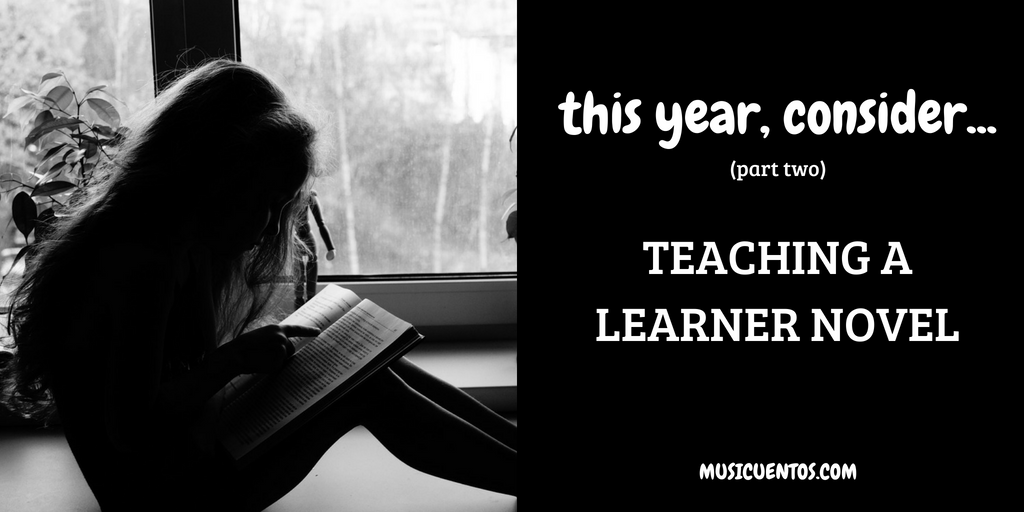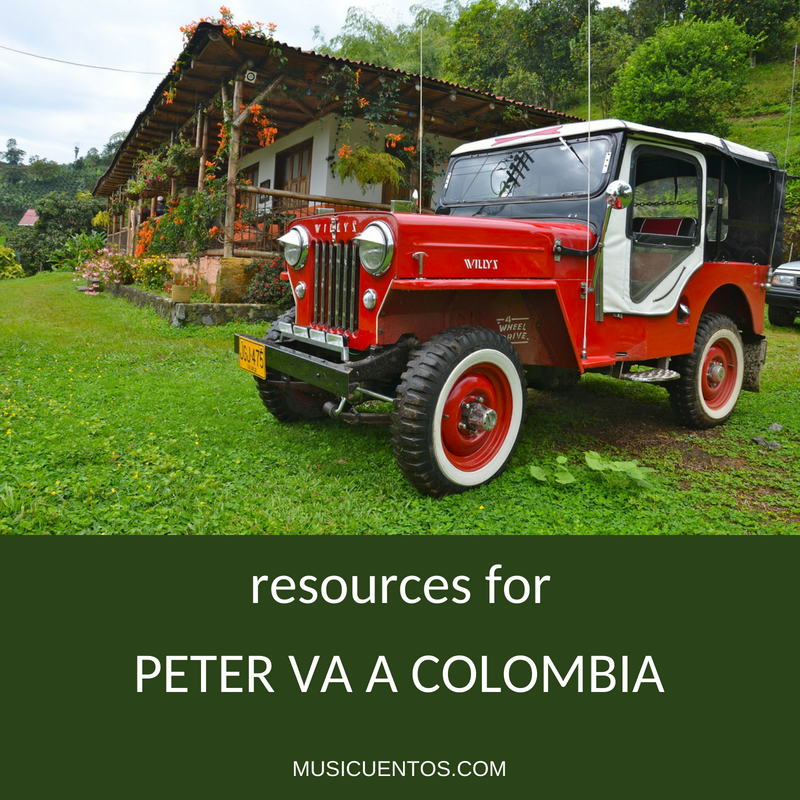When did I first teach a learner novel?
Hmm, think back. From about 2011 through 2014 I taught only intermediate and pre-advanced students and/or the very littles: preschool. I’m pretty sold on the complexity, grit, culture and authenticity that infuses the classroom when you teach an authentic novel as soon as learners can handle it (with a guide, about intermediate mid). And, of course, my littles were getting my simplest stories and significant adaptations of the likes of The Very Busy Spider.
The 2014-2015 school year I was just figuring out how to be a homeschool mom of three kids under 6, including my exhaustingly gifted five-year-old first-grader. Mostly I figured out I needed help. Enter my alliance with a homeschool co-op, a group of homeschool families who meet once a week for structured learning based on what they’ve done at home all week. It’s been a win-win: my kids got a break from me, and I got to feed the part of my soul that’s only happy when I’m teaching Spanish. And this time, I was back with beginners. Real beginners. No-measurable-proficiency day-one beginners, from ages 10-18. At first, I did what I’d done for a long time: I designed my own units, figured out all their at-home activities myself, designed most assessments myself. What does that mean? It means I was super stressed. I rarely went to sleep Thursday nights before 1:30 a.m. I still needed help.
That’s when I decided to try a novel.

I’ve been a friend and fan of the authors involved with Fluency Matters for a long time, since I got to room with some of them at a Central States Conference ages ago. I’ve interacted on Twitter with the authors and the teachers teaching them. But I’d never actually taught one, and I’d only ever read one or two. Until two years ago.
Framing a novice unit within a novel and its primary themes was one of the best decisions I’ve made in the last few years. It was me letting the PLN make my simmer sauce. There are some I love and some I’m indifferent on, and some that are not for me at all, but for my middle grades, Craig Klein‘s books have been a true gift. Once we’d gone through El ratón Pablito, I thought they were ready to tackle something with a little more of a plot. We chose Peter va a Colombia.
Spoiler alert: Craig’s made a significant edit to this novel and I for one can’t wait to see it! He’s fixed some issues he didn’t like about the book and I think you’re going to love what he’s done. All my resources below are for the first edition; if you’re using the update, you’ll need to move things around or get rid of them altogether.
Now I love using learner novels, but I support their content with authentic resources, as you’ll see below. Maris Hawkins said this a lot better and more in-depth than I in her guest post on Secondary Spanish Space on “Incorporating Authentic Resources with Novels.”
From Botero to beaches, from giant shoes to fruit-laden jeeps, we had a great semester exploring Colombia and I’m thankful for Craig’s work as a frame for us. If you’re contemplating teaching this novel, let me offer you the schedule we used. I developed this syllabus for a class of 5th-7th graders meeting once a week for 60 minutes. On weeks we were advancing a chapter or two, we read that material in class, usually acting it out, and did other activities to preview or otherwise highlight the themes and language in the chapter. Then, students did activities at home and reported or turned them in via Edmodo until the next class meeting. If we had read a chapter in class, these activities always included reading the chapter again at home and answering comprehension questions. Often, learners also completed a “Take Your Pick” activity of their choice. Other assignments are listed below, with links if applicable.
You should also know that the final product we were developing in this unit was a three-day itinerary for travel in Colombia. In developing this itinerary for widespread use, I’ve added a fourth day. Learners investigated travel details and weather, planned a suitcase, and then read TripAdvisor reviews in authentic Spanish to choose among options in a particular city in Colombia. Stay tuned for posts on my fun new project, travel itineraries for novice learners. (Psst, click the link, the itinerary for Colombia is actually already available.)
Without further ado,

16 weeks in Colombia
| Week | In class | At home |
|---|---|---|
| 1 | Chapter 1
le gusta; activities; days of the week |
|
| 2 | Intro la escuela with this set of photos, do “sabemos” vs. “necesitamos saber” on vocab to talk about photos; Chapter 2 | Learners compare school photos; mine reviewed previous content on weather in the context of clothing by completing these activities:
|
| 3 | Regions of Colombia (great illustrated map)
Airplane travel; Aeroméxico commercial Song “Corazón en mi maleta” |
|
| 4 | Budget and packing for a trip |
|
| 5 | Chapters 3 & 4
En un museo Fernando Botero |
|
| 6 | Compare and contrast schools in our area and in Colombia
Describing animals in Colombia |
|
| 7 | Nature, weather, and frequency words |
|
| 8 | Chapter 6
Constrast: el pueblo y el campo using resources from Participate’s lesson on this topic in their Spanish 1 course (which I collaborated on). |
|
| 9 | Chapter 7
El desfile de Yipao |
|
| 10 | Chapter 8 |
|
| 11 | Vacation activities: Make a bar graph or pie chart of how many students like to do these activities: nadar, jugar al voleibol, construir castillos, buscar conchas, broncearse, dormir, leerMake & try arepas |
|
| 12 | Chapter 9 |
|
| 13 | Chapter 10 |
|
| 14 | El biblioburro |
|
| 15 | Chapter 11 |
|
| 16 | Itinerary presentations, conversation circles | All done! My learners made yipao centerpieces for our family dinner & display night using Craig’s template. |
One note of brutal honesty, I didn’t give clear directions on what “present your itinerary” meant, and clearly these middle-grades kids weren’t experts yet on what a presentation was even about. The so-called “presentation day” turned out terrible. I got some of them to kinda sorta read what they’d written so they could pretend they’d done a presentation and I wrote off the assignment. It was one of my biggest fails that semester. With middle grades learners, if you’re going to ask for a presentation, model it, ask others to model it, model it again, and give the clearest rubric ever. And break it down into pieces they complete a bit at a time.
As I contemplate this year, I’ve got three novels on my mind. My younger class has requested a Bolivia story (thanks Maris for your El Ekeko simmer sauce!). My high school girls are taking a semester off of novels to pilot my PBLL unit “Coffee, Culture, and Fair Trade,” but I may have them read Noche de oro on their own because they loved Robo en la noche last year. Spring is up in the air in both cases, but for the older class I’m contemplating pushing their proficiency with Vida y muerte en la Mara Salvatrucha so we can get into some really heavy current events. Are you teaching a novel this year? Share your simmer sauce, and I’ll keep sharing mine!
Craig Klein, the author of Peter va a Colombia, previewed this blog post and approved of my sharing my resources here. Let’s support the hard work and dedication of learner novel authors and make sure our supplemental resources aren’t violating their copyright or detracting from the endeavors they have first right to as authors. Stay tuned for my upcoming blog post on the appalling copyright violation across the language teaching field, “It’s time to stop breaking the law. Now.”
 If Musicuentos has significantly helped you in your language teaching journey, consider becoming part of the “thanks” crew on Patreon. “La lotería” patrons receive every resource I produce, whether it’s a $2 activity or a $50 ebook guide, as thanks for their sponsorship.
If Musicuentos has significantly helped you in your language teaching journey, consider becoming part of the “thanks” crew on Patreon. “La lotería” patrons receive every resource I produce, whether it’s a $2 activity or a $50 ebook guide, as thanks for their sponsorship.
3 Comments
Comments are closed.




What an incredible resource! I so appreciate you sharing! My students are going to love every minute of reading this novel!
Great, I can’t wait to hear about it!
[…] No target language audio in your clip? Consider writing out part of the story and dropping key nouns or verbs and having learners choose their own to make a new story. I call this a story swap and I blogged how I used it frequently in teaching learner novels like Peter va a Colombia. […]